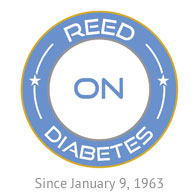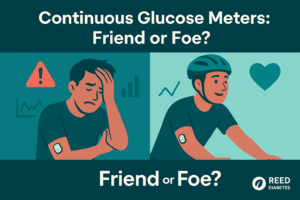Using a Continuous Glucose Monitor (CGM) as part of our diabetes management comes with pros and cons. The benefits include the trends delivered by glucose data every 1-5 minutes. And including that data in algorithms can ease decision-making for insulin dosing and improve blood glucose levels. The cons are both physical and mental. My journey with CGMs is now into two decades … it’s been full of learning, disconnects, reconnects, judgment, and mindfulness.
First Generation Continuous Glucose Monitors (CGMs)
When I first started wearing a CGM in 2006, it felt like a relationship with a high-maintenance partner.
There were tech breakdowns, including false readings, lost signals, and “sensor errors,” many at the worst possible times. In the early days, I often worked with inaccurate data, which made it tough to trust what I was seeing on the screen. I remember a time when, after a challenging week of work, my wife and I went to a nice restaurant to enjoy dinner and get a nice start to the weekend. My CGM has other ideas. It showed my blood sugars climbing above 200, then 300, and moving up. I stressed, and my wife became concerned about me. Dinner did not start well. So I walked out to our car, where I kept a blood meter. I tested, and the meter showed 130 … a far cry from the 300+ number provided by the CGM.
And there was skin irritation—rashes, redness, and adhesive battles that made me question whether this tech was worth the hassle.
And the first-generation CGMs weren’t waterproof. So, when showering (and other times in water), the transmitter had to be covered with a plastic covering to protect it. And those produced more skin irritation. They made showering and water sports a chore.
Next Generation Devices
Over time, the devices became waterproof and more accurate. Some CGMs demonstrated enough accuracy that they didn’t require calibration, and the FDA approved making insulin dosing decisions based on their data.
But even with the improved accuracy, sometimes I felt overwhelmed.
There was data overload. Constant numbers. Trends. Arrows. Alerts. Graphs. And all of it 24/7. What started as a tool for better awareness began to feel like noise I couldn’t escape. I found myself obsessing over every reading, every dip, every spike. The CGM became a scoreboard I couldn’t stop checking.
Adding to the pressure, the CGM apps allow followers, people that we love (and who love us), to watch our numbers in real-time. And have a voice. Their concerns come from a good place, but sometimes, it feels like we have too many coaches on the sideline.
A Move to the Sidelines
Many times, I stepped aside. I disconnected from the adhesives and ever-present data. I went back to finger sticks. It gave me a break and made me feel like I was back in control. But let’s be honest—those benefits didn’t last long.
The truth is, the benefits of a CGM are too great to walk away from. Knowing where your glucose is going – not just where it is – provides a level of insight that’s hard to match. Over time, my time in range improved, my lows became less dangerous, and I started sleeping better at night.
So what changed?
My Solution
The breakthrough didn’t come from tech support or a better adhesive. It came on a bike ride. (I tend to do my best thinking while pedaling.)
I started asking myself a simple question: Is my CGM a friend or a foe?
Up to that point, I had treated it like a foe … something I didn’t control. Something that judged me. Something that made me feel like I was failing.
But what if I started seeing it as a partner? A member of my inner circle? A friend?
Not a perfect friend. But a good one. One who watches out for me. One who tells me the truth … even when it’s hard to hear. One who helps me show up at my best.
This mindset shift changed everything.
Now, I no longer see my CGM as a critic. I see it as a coach. I no longer feel overwhelmed by the data. I feel empowered. And while I still get frustrated sometimes (especially when sensors fail at 2 a.m.), I come back to the same question:
Friend or foe?
Now, I choose a friend.
****************


